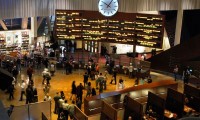>
As millions will be spending their holiday weekend watching marauding robots rip apart Chicago in TRANSFORMERS: DARK OF THE MOON, it’s a fine time to salute some troubling machines of the past:
10. HECTOR (Saturn 3 – 1980): I’m not making this up: in 1980, the director of Singin’ In the Rain made a movie in which Kirk Douglas and Farrah Fawcett played a pair of lovers living together on the moon, until they were attacked first by Harvey Keitel as a homicidal fellow human, and then by Hector, a robot programmed by Keitel to kill Douglas and lust for Fawcett. Hector wasn’t all that terrifying as evil robots go, but the combination of tax shelters and illegal substances in the 1970s and 80s sure made for some scary studio greenlights.
9. CHRISTINE (1983): Not the first killer auto, since it followed The Car, which stalked James Brolin in 1977, and some would also count the truck in Steven Spielberg’s 1973 Duel (I don’t–it had a driver). But Christine, in the hands of Stephen King and director John Carpenter, is the Plymouth Fury who became part of pop culture history. It’s actually shocking that no one has remade this yet. (Fun fact: Keith Gordon, the kid who was terrorized by Christine, left acting to become a writer/director, and Deadline is reporting today that he’ll be doing his next film under the aegis of Christopher Nolan.)
8. ASH (Alien – 1979): The revelation that Ian Holm’s Science Officer aboard the Nostromo was not only an android, but one coldly willing to sacrifice all the human crew members in order to bring the title creature back home, was exceeded only by the alien itself popping out of John Hurt’s chest. Best evil moment: calmly shoving that rolled-up magazine down Sigourney Weaver’s throat.
7. PROTEUS IV (Demon Seed – 1977): The 70s were prime time for fear of computers taking over the world (discuss amongst yourselves), and one of the most evil was Proteus IV. It took control of the systems powering Julie Christie’s house, and in a major step forward for evil computers, it managed to impregnate her with sperm synthesized from her own cells. In the creepy ending, theit newly-born, human-appearing baby spoke with the voice of Proteus.
6. ROY BATTY (Blade Runner – 1982): Think of it when you look at this summer’s unexciting franchise pictures: during the summer of 1982, not only were ET, Star Trek II: The Wrath of Khan, Poltergeist, Tron and An Officer and a Gentleman released, but the season’s boxoffice disappointment was what is now widely considered Ridley Scott’s masterpiece. Roy Batty, the leader of a group of killer replicants, was so soulful as played by Rutger Hauer (“all those moments will be lost in time, like tears in rain; time to die”) that his hard-earned humanity almost outstripped his evil.
5. THE GUNSLINGER (Westworld – 1973): Before Michael Crichton came up with the idea of a theme park with live dinosaurs, he created this adult resort where, as the tagline of the time said, “Nothing can go worng.” In particular, tourists Richard Benjamin and James Brolin found themselves pursued by a wild west killer who looked just like Yul Brynner and who Just. Wouldn’t. Stop. Clearly a film James Cameron kept in his mind for the next decade of his career.
4. COLOSSUS (Colossus: The Forbin Project – 1970): The “cutting-edge” technology in this thriller is so tame now that it’s unintentionally comic, but at the time, this was an all-powerful computer system to give one pause. Think of it as the Doomsday Machine from Dr. Strangelove with a chip on its shoulder; created as the ultimate defense, it recognized the puniness of its human creators and took control for itself. Its best line was its last in the movie: “In time, you will come to regard me not only with respect and awe… but with love.” (This is one of those pictures that’s constantly in development for a remake, but after 40 years, it hasn’t happened yet.)
3. CYLONS (Battlestar Galactica – 1978/2004): Whether as straightforwardly violent “toasters” or synthesized humans, these mechanical beings meant business. In Ron Moore’s brilliant reboot, not only were they, for the most part, visually impossible to distinguish from humans, but they had a morality and belief system equal, and arguably superior, to those of their flesh-and-blood forebears. They could casually destroy a planet, and then mount a sustained argument for why it was the right thing to do; their existence called into question the very concept of what it means to be a human.
2. SKYNET AND ITS SPAWN (The Terminator series – 1984/1991/2003/2008/2009): At this point, Skynet doesn’t need to destroy all of humanity; it could just coast on its merchandising revenues. The most resilient and relentless of sentient machines, it finds new models to send back in time for every sequel, and while occasionally John Connor’s resistence manages to send back a good Terminator, mostly these things just want to kill everyone who gets in their way.
1. HAL 9000 (2001: A Space Odyssey – 1968): The granddaddy of all killer computers, and still the one others struggle to equal; in Stanley Kubrick’s astonishing conception, HAL was more human than the people it was killing. The scene of HAL’s destruction–its step-by-step lobotomization–is one of the scariest, funniest, saddest sequences in all of film history.





